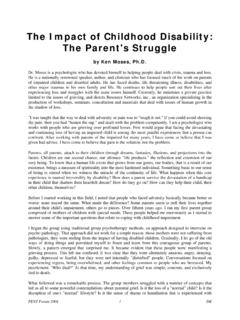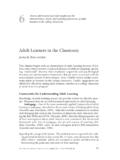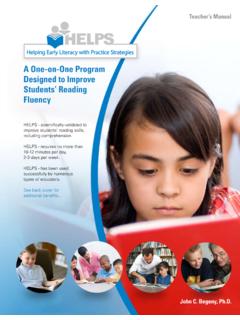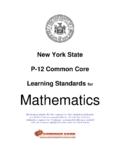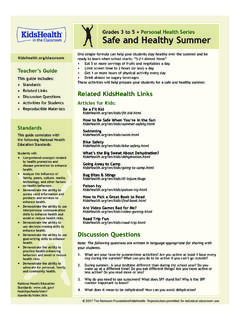Transcription of WHAT IS YOUR CLASSROOM MANAGEMENT …
1 Used with permission of Department of Special Education, Indiana University, Terminology has been altered from the original to match trainings by Diana Browning Wright For original, see: 1 WWHHAATT IISS YYOOUURR CCLLAASSSSRROOOOMM MMAANNAAGGEEMMEENNTT PPRROOFFIILLEE?? Answer these 12 questions and learn more about your CLASSROOM MANAGEMENT profile. The steps are simple: Read each statement carefully. Write your response, from the scale below, on a sheet of paper. Respond to each statement based upon either actual or imagined CLASSROOM experience. Then, follow the scoring instructions below. It couldn't be easier! 1. = Strongly Disagree 2. = Disagree 3. = Neutral 4. = Agree 5. = Strongly Agree (1) If a student is disruptive during class, I assign him/her to detention, without further discussion.
2 (2) I don't want to impose any rules on my students. (3) The CLASSROOM must be quiet in order for students to learn. (4) I am concerned about both what my students learn and how they learn. (5) If a student turns in a late homework assignment, it is not my problem. (6) I don't want to reprimand a student because it might hurt his/her feelings. (7) Class preparation isn't worth the effort. (8) I always try to explain the reasons behind my rules and decisions. (9) I will not accept excuses from a student who is tardy. (10) The emotional well-being of my students is more important than CLASSROOM control. Used with permission of Department of Special Education, Indiana University, Terminology has been altered from the original to match trainings by Diana Browning Wright For original, see: 2(11) My students understand that they can interrupt my lecture if they have a relevant question.
3 (12) If a student requests a hall pass, I always honor the request. To score your quiz, Add your responses to statements 1, 3, and 9. This is your score for the authoritarian style. Statements 4, 8 and 11 refer to the authoritative style. Statements 6, 10, and 12 refer to the democratic style. Statements 2, 5, and 7 refer to the laissez-faire style. The result is your CLASSROOM MANAGEMENT profile. Your score for each MANAGEMENT style can range from 3 to 15. A high score indicates a strong preference for that particular style. After you have scored your quiz, and determined your profile, read the descriptions of each MANAGEMENT style. You may see a little bit of yourself in each one. As you gain teaching experience, you may find that your preferred style(s) will change.
4 Over time, your profile may become more diverse or more focused. Also, it may be suitable to rely upon a specific style when addressing a particular situation or subject. Perhaps the successful teacher is one who can evaluate a situation and then apply the appropriate style. Finally, remember that the intent of this exercise is to inform you and arouse your curiosity regarding CLASSROOM MANAGEMENT styles. The CLASSROOM MANAGEMENT styles are adaptations of the parenting styles discussed in Adolescence, by John T. Santrock. They were adapted by Kris Bosworth, Kevin McCracken, Paul Haakenson, Marsha Ritt er Jones, Anne Grey, Laura Versaci, Julie James, and Ronen Hammer.
5 Some researchers call the democratic style, laissez-faire , and some refer to laissez-faire style as indifferent . All agree on characteristics and outcomes of the four styles. Authoritarian The authoritarian teacher places firm limits and controls on the students. Students will often have assigned seats for the entire term. The desks are usually in straight rows and there are no deviations. Students must be in their seats at the beginning of class and they frequently remain there throughout the period. This teacher rarely gives hall passes or recognizes excused absences. Often, it is quiet. Students know they should not interrupt the teacher. Since verbal exchange and discussion are discouraged, the authoritarian's students do not have the opportunity to learn and/or practice communication skills.
6 This teacher prefers vigorous discipline and expects swift obedience. Failure to obey the teacher usually results in detention or a trip to the principal's office. In this CLASSROOM , students need to follow directions and not ask why. Used with permission of Department of Special Education, Indiana University, Terminology has been altered from the original to match trainings by Diana Browning Wright For original, see: 3At the extreme, the authoritarian teacher gives no indication that he\she cares for the students. Mr. Doe is a good example of an authoritarian teacher. His students receive praise and encouragement infrequently, if at all. Also, he makes no effort to organize activities such as field trips. He feels that these special events only distract the students from learning.
7 After all, Mr. Doe believes that students need only listen to his lecture to gain the necessary knowledge. Students in this class are likely to be reluctant to initiate activity, since they may feel powerless. Mr. Doe tells the students what to do and when to do it. He makes all CLASSROOM decisions. Therefore, his style does little to increase achievement motivation or encourage the setting of personal goals. One Middle-school pupil reacts to this teaching style: I don't really care for this teacher. He is really strict and doesn't seem to want to give his students a fair chance. He seems unfair, although that's just his way of getting his point across. Authoritative The authoritative teacher places limits and controls on the students but simultaneously encourages independence.
8 This teacher often explains the reasons behind the rules and decisions. If a student is disruptive, the teacher offers a polite, but firm, reprimand. This teacher sometimes metes out discipline, but only after careful consideration of the circumstances. The authoritative teacher is also open to considerable verbal interaction, including critical debates. The students know that they can interrupt the teacher if they have a relevant question or comment. This environment offers the students the opportunity to learn and practice communication skills. Ms. Smith exemplifies the authoritative teaching style. She exhibits a warm and nurturing attitude toward the students and expresses genuine interest and affection.
9 Her CLASSROOM abounds with praise and encouragement. She often writes comments on homework and offers positive remarks to students. This authoritative teacher encourages self-reliant and socially competent behavior and fosters higher achievement motivation. Often, she will guide the students through a project, rather than lead them. A student reacts to this style: I like this teacher. She is fair and understands that students can't be perfect. She is the kind of teacher you can talk to without being put down or feeling embarrassed. Used with permission of Department of Special Education, Indiana University, Terminology has been altered from the original to match trainings by Diana Browning Wright For original, see: 4 Democratic The democratic teacher places few demand or controls on the students.
10 "Do your own thing, describes this CLASSROOM . This teacher accepts the student's impulses and actions and is less likely to monitor their behavior. Mr. Jones uses a democratic style. He strives to not hurt the student's feelings and has difficulty saying no to a student or enforcing rules. If a student disrupts the class, Mr. Jones may assume that he is not giving that student enough attention. When a student interrupts a lecture, Mr. Jones accepts the interruption with the belief that the student must surely have something valuable to add. When he does offer discipline, it is likely to be inconsistent. Mr. Jones is very involved with his students and cares for them very much. He is more concerned with the students' emotional well-being than he is with CLASSROOM control.







